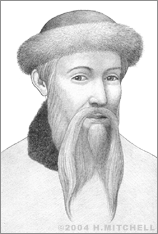Johann Gutenberg
The printing press, invented by German goldsmith Johann Gutenberg in 1448, has been called one of the most important inventions in the history of humankind. For the first time, the device made it possible for the common man, woman, and child to have access to books, which meant that they would have the unprecedented ability to accumulate knowledge.
Before the invention of the printing press, the majority of books were written and copied by hand. Block printing was becoming more popular, which involved carving each page of a text into a block of wood and pressing each block onto paper. Because these processes were so labor-intensive, books were very expensive, and only the rich could afford them.
Believed to have been born in Mainz, Germany, in approximately 1399, Gutenberg, nee Johann Gensfleisch later adopted his family’s settling place as his last name. He was trained as a goldsmith, gem cutter, and metallurgist. For some time he lived in Strasbourg, most likely in the late 1430s to early 1440s. By then, he had been losing money in his business and began looking for a way to make money to pay off his debts.
He started working on a device that would make it possible to print texts using movable blocks of letters and graphics. These blocks, used with paper, ink, and a press, would make it possible to print books much faster and more cheaply than ever before. He used metals that he was familiar with – lead, antimony, and tin – to cast 290 blocks of letters and symbols, and he created a linseed- and soot-based ink of the consistency he believed to be ideal for printing on handmade paper. He adapted a wine press that allowed him to slide paper in and out of it and to squeeze water from the paper after printing.
He tested his moveable type machine by printing a Latin book on speech-making in 1450. When this endeavor was successful, he embarked on his most famous project, the printing of "The Gutenberg Bibles."
The bibles, printed in Latin, gained fame as the first books ever printed in Europe and the first bibles printed in history. Two hundred copies were made, each complete with beautiful illustrations and vibrant colors. Part of Gutenberg’s genius was his technique for creating blocks to represent the calligraphy done in handmade volumes, so that the richness of the original texts could be preserved. Characters and illustrations were later hand-illuminated. Today, only 22 of the original Gutenberg bibles are known to be in existence.
Gutenberg’s business partner Johann Fust eventually gained ownership of the printing business and completed the printing of the bibles. This was the result of a deal made between the two men, necessitated by debts that Gutenberg owed to Fust.
Gutenberg died in approximately 1468 in Mainz. It should be noted that others in history claim to have come up with the idea of movable type earlier than Gutenberg did, including a Dutchman and a Chinese inventor. A system similar to his is said to have also been used in the 12th century in Korea. But for whatever reason, Gutenberg’s endeavor was the first to be successful, and his printing press had a revolutionary impact on history and the entire world.
The printing press and all that it brought to the masses helped to inspire a religious revolution, as families were, for the first time, able to possess a Bible for their own interpretation. In fact, the Protestant Revolution wouldn’t have been possible without the availability of the printing press. It also factored into the progress of science, general education, and is said to have been key in moving the world out of the Medieval era into the Early Modern period.


